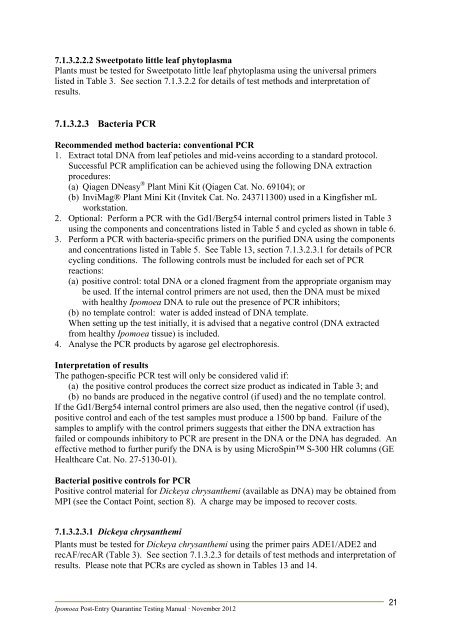Ipomoea (Sweetpotato/Kumara) Post-Entry Quarantine Testing Manual
Ipomoea (Sweetpotato/Kumara) Post-Entry Quarantine Testing Manual
Ipomoea (Sweetpotato/Kumara) Post-Entry Quarantine Testing Manual
You also want an ePaper? Increase the reach of your titles
YUMPU automatically turns print PDFs into web optimized ePapers that Google loves.
7.1.3.2.2.2 <strong>Sweetpotato</strong> little leaf phytoplasma<br />
Plants must be tested for <strong>Sweetpotato</strong> little leaf phytoplasma using the universal primers<br />
listed in Table 3. See section 7.1.3.2.2 for details of test methods and interpretation of<br />
results.<br />
7.1.3.2.3 Bacteria PCR<br />
Recommended method bacteria: conventional PCR<br />
1. Extract total DNA from leaf petioles and mid-veins according to a standard protocol.<br />
Successful PCR amplification can be achieved using the following DNA extraction<br />
procedures:<br />
(a) Qiagen DNeasy ® Plant Mini Kit (Qiagen Cat. No. 69104); or<br />
(b) InviMag® Plant Mini Kit (Invitek Cat. No. 243711300) used in a Kingfisher mL<br />
workstation.<br />
2. Optional: Perform a PCR with the Gd1/Berg54 internal control primers listed in Table 3<br />
using the components and concentrations listed in Table 5 and cycled as shown in table 6.<br />
3. Perform a PCR with bacteria-specific primers on the purified DNA using the components<br />
and concentrations listed in Table 5. See Table 13, section 7.1.3.2.3.1 for details of PCR<br />
cycling conditions. The following controls must be included for each set of PCR<br />
reactions:<br />
(a) positive control: total DNA or a cloned fragment from the appropriate organism may<br />
be used. If the internal control primers are not used, then the DNA must be mixed<br />
with healthy <strong>Ipomoea</strong> DNA to rule out the presence of PCR inhibitors;<br />
(b) no template control: water is added instead of DNA template.<br />
When setting up the test initially, it is advised that a negative control (DNA extracted<br />
from healthy <strong>Ipomoea</strong> tissue) is included.<br />
4. Analyse the PCR products by agarose gel electrophoresis.<br />
Interpretation of results<br />
The pathogen-specific PCR test will only be considered valid if:<br />
(a) the positive control produces the correct size product as indicated in Table 3; and<br />
(b) no bands are produced in the negative control (if used) and the no template control.<br />
If the Gd1/Berg54 internal control primers are also used, then the negative control (if used),<br />
positive control and each of the test samples must produce a 1500 bp band. Failure of the<br />
samples to amplify with the control primers suggests that either the DNA extraction has<br />
failed or compounds inhibitory to PCR are present in the DNA or the DNA has degraded. An<br />
effective method to further purify the DNA is by using MicroSpin S-300 HR columns (GE<br />
Healthcare Cat. No. 27-5130-01).<br />
Bacterial positive controls for PCR<br />
Positive control material for Dickeya chrysanthemi (available as DNA) may be obtained from<br />
MPI (see the Contact Point, section 8). A charge may be imposed to recover costs.<br />
7.1.3.2.3.1 Dickeya chrysanthemi<br />
Plants must be tested for Dickeya chrysanthemi using the primer pairs ADE1/ADE2 and<br />
recAF/recAR (Table 3). See section 7.1.3.2.3 for details of test methods and interpretation of<br />
results. Please note that PCRs are cycled as shown in Tables 13 and 14.<br />
<strong>Ipomoea</strong> <strong>Post</strong>-<strong>Entry</strong> <strong>Quarantine</strong> <strong>Testing</strong> <strong>Manual</strong> · November 2012<br />
21

















